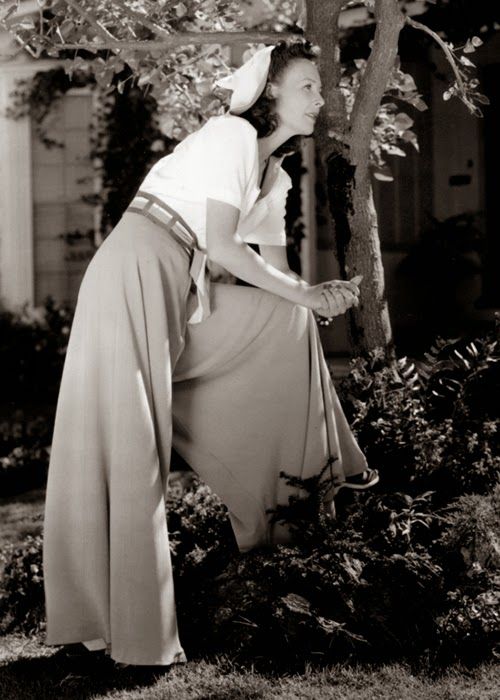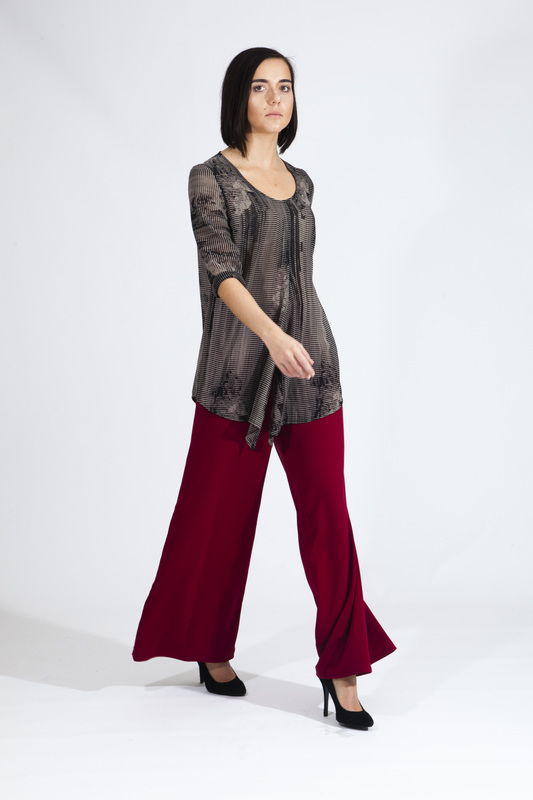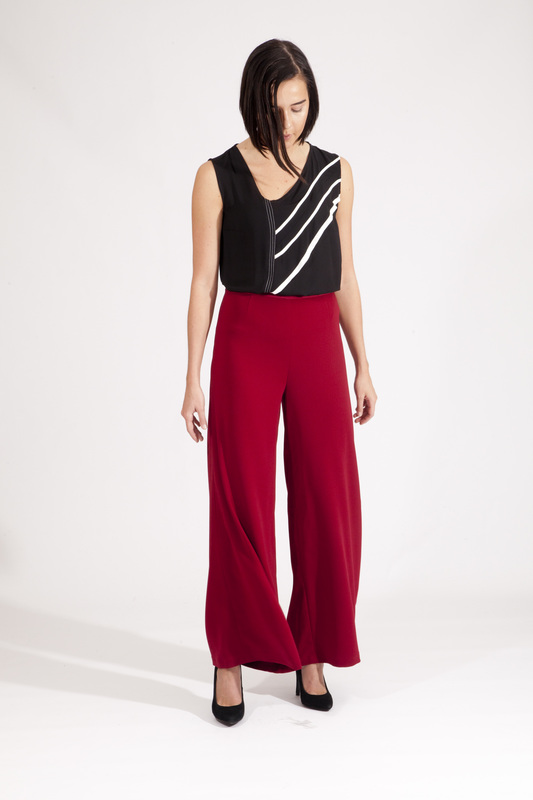|
Palazzo pants have been making women feel "pretty" since the 1930's but they stand for so much more than just a pant style- they are part of history and have evolved along with women's movements throughout the years. First introduced by Coco Chanel, who is responsible for classic trends we still wear today, palazzo pants were later adopted by Hollywood actresses like Katharine Hepburn and Marlene Dietrich. The palazzo pant style surfaced as a necessity and definitely out of creativity- many restaurants and public places were frowning upon women wearing trousers so women got creative and come up with a wide legged style that resembled a skirt but still possessed the comfort of pants. It was an innovation that eventually changed fashion history and gave us what we know as palazzo pants and the culottes (a shorter version of wide legged pants). If you do a little snooping around on dictionary.com, you can find the literal meaning of the word "palazzo" which originates from Italy and is described as "a large, splendid residence or public building, such as a palace or museum". It comes as no surprise then that this fabulous wide legged pant ended up with its well deserved title- the style itself is grand and architectural resembling the structure and size of a magnificent building. They are certainly just as resilient as a museum or palace because they have lasted in fashion throughout the years and keep making a come back. We've witnessed the palazzo pants go from resembling a maxi skirt to being incorporated into a jumpsuit in the 1960's and becoming more tailored in recent years. No matter what form they are presented in, one thing is for sure: they are here to stay and will keep making a come back in future years. Here are 4 reasons why we think so: 1. They are comfortable. It is no surprised that the reason they were created in the first place was their ability to be comfortable but still feminine. Women will always seek comfort especially as we move into a fast paced environment where we're always multi tasking. 2. There are infinite ways to style them. It really is a well-rounded clothing item and can be styled a variety of different ways. A simple pair of palazzo pants can work just as well with a blazer as it would with a casual blouse. It also gives the wearer the control to make them casual or more dressed up simply by mixing them with the right pair of shoes (we think Palazzo pants and heels are a match made in heaven) 3. They offer design versatility. Palazzo pants are the easiest to take from casual to formal and work with any fabric choice and design element. They work just as well as a beach cover-up as they do in a formal setting at the office- All that's necessary for the transition is the appropriate choice of fabric. We've seen them work well in summer florals and bold prints as well as in a classic suiting fabric. It's the A-line character of the pant legs that will always give it a classic look. 4. They are flattering! Palazzo pants look beautiful on both curvy and slim figures. They flare out from the hip into an A-line shape to create a clean, proportionate look. They can make your legs appear longer and more slender but also maintains an hourglass characteristic by accentuating the waist. Doina Alexei Palazzo Pants from F/W 16 collection Looking for more unique stuff? Check out our 11:11 Jacket, the magical jacket that transforms into a bag!
0 Comments
Leave a Reply. |
The Blog:A journey into our design process, sewing tutorials, fashion tips, and all the inspiring people and things we love. Doina AlexeiDesigner by trade and dressmaker at heart. I spend most of my days obsessing over new fabrics and daydreaming new ideas. Sadie
Executive Assistant & Client Relations Manager Archives
November 2019
Categories
All
|
-
Sewing Tutorials
-
Basics
>
- Aligning Pattern Grainlines To Fabric
- Preparing Fabrics For Sewing
- Pinning Sewing Patterns To Fabric
- Placing Sewing Patterns On Fabric For Cutting
- Rotary Cutters or Fabric Scissors?
- Cutting The Sewing Patterns
- What Are Notches And How To Use Them In The Sewing Process
- Transferring Notches From Pattern To Fabric
- Transferring Seamlines to Fabric
- Staystitching
- Backstitching: A Complete Guide
- Hand Basting: A Complete Guide
- Sewing Continuous Bias Binding
- Darts >
-
Sewing Seams
>
- The Basics Of Seams And Seam Allowance
- How To Sew A Straight Seam
- Sewing Curved Seams
- Sewing Corner Seams
- Trimming And Grading Seam Excess
- Notching/Clipping Seam Allowance for Tension Release
- Sewing Topstitched Seams
- Sewing Corded Seams
- Sewing A Slot Seam
- Sewing A Gathered Seam
- Sewing Bias Seams
- Sewing Seams With Ease
- Sewing Seams With Crossing Seamlines
- Sewing Unlike Fabric Seams
- How To Iron Seams: Ironing Tools And Conventions
- Sewing With Knit Fabrics
- Understanding Stitch Length And Tension
- Sewing Unique Fabric Seams
-
Seam Finishes
>
- Seam Finishing Techniques - Overview
- Applying A Pinked Seam Finish
- Applying A Bias Bound Seam Finish
- Serging And Zigzag Seam Finishes
- Sewing A Self-Bound Seam Finish
- Sewing A French Seam Finish
- Sewing A Hong Kong Seam Finish
- Sewing A Mock French Seam Finish
- Sewing A Turned-and-Stitched Seam Finish
- Sewing Overcast Hand-Applied Seam Finishes
- Sewing A Flat Felled Seam
- Sewing A Hairline Seam Finish
-
Hem Finishes
>
- Garment Hem Finishes: Overview
- Sewing A Double Fold Hem Finish
- Sewing A Single Fold Hem Finish
- Sewing Bound Hem Finishes
- Sewing An Exposed Double Layer Bound Hem
- Sewing A Folded-Up Bound Hem with Pre-folded Binding
- Sewing A Hong Kong Hem Finish
- Sewing A Band Hem Finish
- Sewing A Bias Faced Hem Finish
- Sewing A Twill Tape Hem Finish
- Sewing A Rolled Hem Finish
- Sewing A Shaped Hem Facing
- Using Fusible Hem Tape And Webbing
- Finishing A Lace Fabric Hem
- Finishing A Leather Hem
- Sewing Faced Hem Corners
- How To Finish Lining At The Hem
- Finishing Fabric Corners by Mitering >
- Interfacing A Hemline: Lined And Unlined Examples
-
Sewing Pockets
>
- Curved Patch Pocket With Flap
- Unlined Square Patch Pockets
- Lined Patch Pockets: Two Ways
- Extension On-Seam Pockets
- Separate On-Seam Pocket
- Front Hip Pockets
- Bound Double Welt Pocket
- Double Welt Pocket With Flap
- Self-Welt Pocket (Using Single Fabric Layer)
- Slanted Welt Pocket (Hand-Stitched)
- Faced Slash Pockets: Overview >
-
Sewing Zippers
>
- Sewing Zippers: General Information
- Sewing A Centered Zipper
- Sewing A Lapped Zipper
- Sewing An Invisible Zipper
- Sewing A Fly Front Zipper
- Sewing A Closed-End Exposed Zipper (No Seam)
- Sewing An Exposed Separating Zipper
- Sewing Hand Stitched Zipper Applications
- Sewing A Zipper Underlay
- Sewing A Placket-Enclosed Separating Zipper
- Sleeveless Finishes >
-
Neckline Finishes
>
- Sewing A Neck Shaped Facing
- Sewing An All-In-One Neck Facing
- Neck And Garment Opening Combination Facings >
- Sewing A Bias Faced Neckline Finish
- Sewing A Band Neckline Finish
- Bound Neckline Finishes: Overview >
- Sewing A Semi-Stretch Strip Band Neckline
- Ribbed Neck Band And Classic Turtleneck
- Decorative Neckline Finishes >
- Finishing Facing Edges >
-
Extras
>
- A Complete Guide on Interfacing
- Sewing Bound Spaghetti Straps
- Sewing Spaghetti Straps To A Faced Neckline
- Sewing Ruffles: Overview
- Patterning And Sewing A Circle Ruffle
- Sewing A Gathered Heading Ruffle
- Sewing Double Layer Gathered Ruffles
- Sewing A Gathered Ruffle Into A Seam
- Sewing A Gathered Ruffle To A Fabric Edge
- Sewing A Fabric Surface Slit
- Sewing A Slit Seam
- Hand-Applied Straight Stitches
- Hand-Applied Blind Stitches
- Hand-Applied Overedge Stitches
- Hand-Applied Tack Stitches
- Hand-Applied Decorative Stitches
-
Basics
>
- Custom Bridal
- Custom Apparel
- About
- Blog
Services |
Company |
|






 RSS Feed
RSS Feed

